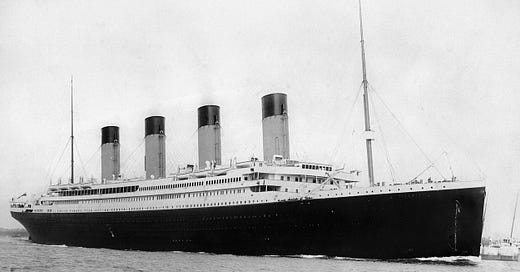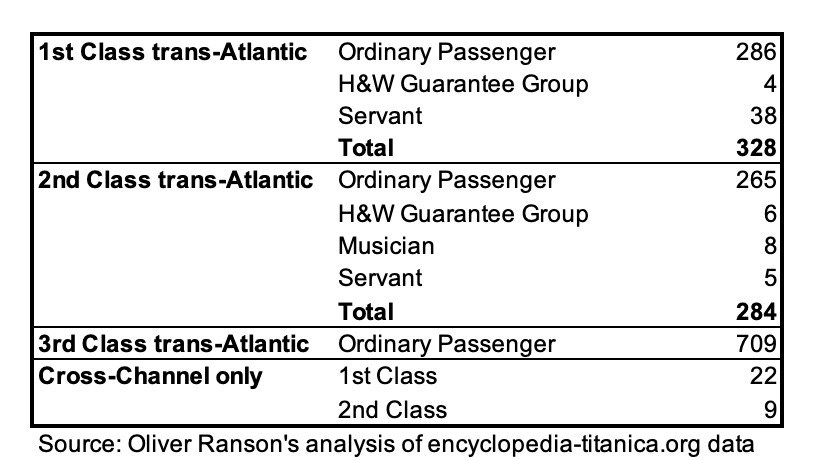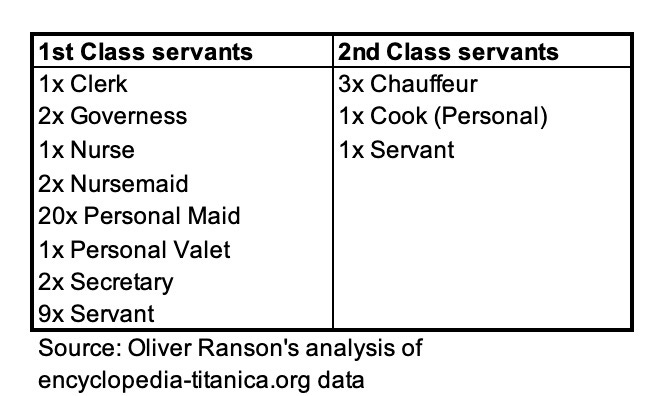Revenue Management System (RMS) Titanic: The Second Class
Airline pricing strategies are older than you think
It is Titanic week! 113 years ago today the grand liner RMS Titanic and her passengers were steaming across the North Atlantic to their tragic destiny.
But imagine if Titanic had not struck the iceberg and continued back-and-forth carrying passengers and cargo, and of course the mails, between the old and new worlds? She would have delivered a lot of revenue for her owners the White Star Line.
Why is Titanic relevant to airline revenue today?
Due to the tragedy a large amount of information is easily available covering who was travelling, where they were going and what they paid for their tickets.
These sources are interesting for airline specialists seeking to understand how today’s offer-order management (formerly revenue management and pricing, formerly revenue optimisation…) have evolved.
Airlines reckon they are pretty canny today with their whizzy algorithms and pricey vendors. It turns out there is not much new under the Sun and White Star Line had the same ideas a hundred years ago. Since the whole of airline demand forecasting is based on history, this should not come as a surprise for anyone!
Two years ago (see article) I wrote about what Titanic’s revenue looked like. I explained how fares in 1912 compared to today’s. I also analysed Titanic’s ability to generate ancillary revenue from first class facilities like the Turkish baths and a la carte restaurant.
It also covered additional revenue from cabin flexibility, as some of Titanic’s accommodation could be switched between first and second class, or between second and third class.
Last year (see article) I wrote about how different passengers paid different prices for the same product in First Class. Revenue management 1912 style!
Both of those articles were quite first classy. The 1997 movie was third classy too. Second Class is often forgotten, so I will be focusing on that today.
Who travelled in Second Class?
1,321 passengers set out to cross the Atlantic on Titanic. Another 31 crossed the English Channel. The breakdown is shown in the table below:
The H&W Guarantee Group were employees of the Harland & Wolff ship yard in Belfast. Since Titanic was on her maiden voyage they were making the trip to check that all was ship-shape, under the leadership of Thomas Andrews. Sadly none survived. It is interesting to compare their roles by their cabin class, as shown in the table below.
The members with First Class tickets do look a bit more senior than those with Second. Just like business travel today.
The musicians were the ship’s band, led by Wallace Hartley. They played to the end, heroes all, and none survived.
Employed by CW & FN Black of Liverpool and not the White Star Line, they each held a Second Class ticket. Their room on E Deck, not numbered but next to E106 near the stern, had a special cupboard for their instruments.
The Servants were employees of First Class passengers. Those ticketed in First Class, received rooms near to their employers’ staterooms and ate in a special Servants’ saloon. They were definitely not considered ordinary First Class passengers.
These passengers would have carried out duties for their employers during the voyage.
Those Servants tickets in Second Class on the other hand ate in the main saloon alongside regular Second Class passengers. Taking a look at the table below, it is unlikely that they were performing duties during the voyage.
[ASIDE: In all my travels I have only seen someone travelling with a Servant once. It was on Heathrow to Delhi in 2019 and I was flying BA in First. A chap I had noticed sitting on his own in the Concorde Room carried on the bag for another passenger in First and put it in the overhead locker for him. The fellow then went back behind the curtain to take a seat elsewhere.]
It is interesting to read the list of professions (that we know about) for the Second Class passengers. These are shown in the table below.
Some of these look like the sort of professions that we would associate with premium cabin travel today – Doctors, Engineers, Advertising Consultants, Oil Workers etc.... Others do not – Farm Labourers, Chauffeurs and Butcher’s Assistants.
This reminds us that the world in 1912 was in many respects quite different to the world today. Skilled artisans could and often did live well. Remember that in 1912 incomes were much lower in real terms than today, even for the rich.
So if it would take you a month to earn enough for a ticket on Titanic today it would probably have taken you take six to eight months in 1912.
What did it cost to travel in Second Class on Titanic?
But in many other respects it was similar. Even for Doctors and Advertising Consultants, the fare difference between First and Second Class was worth considering, summarised in the table below.
There are 20 Shillings (s) in the Pound (£) and 12 Pence (d) in the Shilling.
For a bargain-savvy passenger the Second to First upgrade would have been around £10 9s 6d. That is around £2,004 in today’s money. Last-minute-type upgrades would have been around £17 13s, or £2,208 today.
Comparing Second Class fares with 75th percentile and 95th percentile First Class fares is not relevant because I find it hard to believe that people would choose between a higher-end First Class stateroom and Second Class. They might however choose between lower-end First and Second.
Affordable for many professional people today, this would not have been the case in 1912 because incomes were lower in real terms and it would take more months to earn the money. However unlike air travel today the voyage was much longer and duller, and people did not do it so often, so incentives to upgrade were high. Creature comforts, better food and swankier lounges made a difference in 1912, just as they do today.
I still maintain that almost anybody buying a First, Business or Premium ticket on an airline today would probably be travelling First Class in the days of the ocean liners.
Many Economy travellers would too, because air travel journey times are so much shorter and people saying they would rather save the money and stay in a nicer hotel is well known.
Third Class from the days of the liners does not really exist in air travel today.
It is interesting to note that First Class provided 78.1% of White Star’s non-Third revenue, despite there being a similar number of non-Servant, non-Musician, non-Guarantee Group passengers. Titanic was most certainly a First Class-focused ship.
How did White Star structure the Second Class fares?
Inspecting the Second Class rate booklet for Titanic’s sister ship Olympic shown on page 12 of Titanic: The Ship Magnificent Vol. 2 by Bruce Beveridge and others is interesting. The fares shown are for the 1911 season as Titanic is shown as “Building”.
There were child fares too, which I have not shown.
The fare structure shows a sophisticated pricing strategy.
1. Clear seasonality – peak westbound was Aug, Sep and Oct; peak eastbound was before 28-Jun-1911. Since Olympic’s maiden voyage departed Southampton on 14-Jun-1911 and it took seven days to cross the pond, she clearly only got in one peak eastbound trip during the 1911 season.
2. The off-peak fare structure is not particularly differentiated, with off-peak outside rooms 10s (4.2% more expensive) on D Deck only and every other room the same price – Titanic’s maiden voyage was off-peak and many Second Class passengers had a cabin to themselves or shared only with friends and family
3. The peak fare structure is highly differentiated, with larger and more desirable rooms more expensive than others:
The best four-berth outside rooms on E deck were 10s per adult more expensive if full, 5s 4d per adult more expensive if occupied by three and £1 0s per adult more expensive if occupied by two
The inside two-berth rooms with a sofa on E Deck were £1 10s per adult more expensive than those without on the westbound journey
4. White Star offered price points for two or three adults occupying a four berth room
5. White Star charged between £1 0s and £2 0s per adult more on the westbound passage than the eastbound
Did Second Class passengers have any ancillary purchase opportunities?
Yes! The rate sheet shows:
1. Deck chair hire = 4s per voyage
2. Steamer rug hire = 4s per voyage
3. Dog fare = £2 to £5 per dog, with further details not specified but presumably a higher fare was charged for larger dogs
4. Excess baggage at 1s “per foot”, I am not quite sure what this means but am guessing that a one cubic feet piece would be charged 3s, one for the length, one for the breadth and one for the height.
When airlines innovate by introducing charges for the window seat or extra services, they are following a centuries old tradition.
Read more on Airline Revenue Economics
RMS Titanic – Revenue Management System
Revenue Management on RMS Titanic









